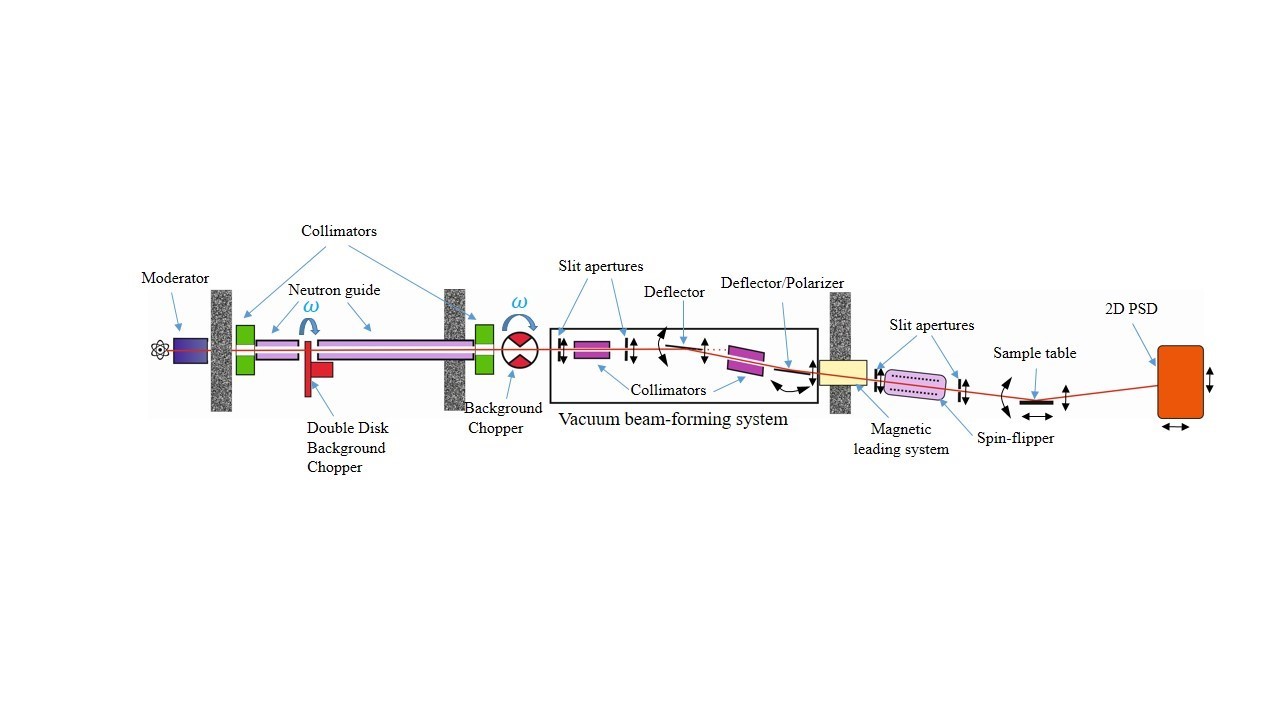Multifunctional neutron reflectometer with horizontal sample plane
Instrument responsible

Principal scheme of the reflectometer GRAINS
Current parameters
| Neutron flux at the sample: | 2×106 s-1 cm-2 |
| Wavelength range: | 0.05 – 1 nm |
| Angle range: | 2 – 20 mrad |
| Q-range: | 0.05 – 3 nm-1 |
| Q-resolution: | < 5% |
Sample environment equipment:
Cells for interfaces: solid/liquid, air/liquid, air/solid
Thermostat: (-20 ÷ +180) °C
Anti-vibrational table
Potentiostat/galvanostat (with Impedance spectroscopy option) Bio-logic SP-200
Langmuir—Blodgett trough ODO 'MICROTESTMACHINES' LT-2211
Description
The GRAINS project - multifunctional neutron reflectometer with horizontal sample plane - started in 2007. Main contributors to the project: BMBF (Germany) - HAS (Hungary) - FLNP JINR (Russia) - PNPI NRC KI (Russia) - KNU (Ukraine). At present, stage I (basic configuration) has been completed, which provides the following research options:
- reflectometry in vertical scattering plane;
- liquid-containing interface;
- scattering of polarized neutrons (without polarization analysis).
Main feature of the GRAINS reflectometer
In addition to the solid-solid interfaces the horizontal sample plane (vertical scattering plane) makes it possible to measure liquid-containing interfaces including liquid surfaces and liquid-solid interfaces.
Derived information
Nuclear scattering length density depth profile of layered nanosystems including mean densities at interface, mean width of the interface, roughness between layers, nuclear correlation length or period of ordering over depth.
Additional information by polarized neutrons
Magnetic scattering length density depth profile (magnetization) for layered systems (layer by layer magnetometry) including mean magnetization at interface, specific magnetic width of the interface, magnetic roughness between layers, magnetic correlation length or period of ordering over depth.
Brief description of the reflectometer and principal scheme
The GRAINS reflectometer is intended for the determination of the reflectivity of thermal neutrons in various dimensions from surfaces and interfaces. The system under investigation is placed horizontally (i.e. reflection is detected in the vertical plane). The initial neutron beam coming from the cold moderator located near the active core is collimated in the horizontal plane by a set of slit apertures. To control the angle at which the beam is incident on the sample surface (0.5 - 25 mrad), a special neutron mirror (deflector) is used. Since the deflector reflects only thermal neutrons (wavelength > 0.05 nm), it additionally separates the thermal neutron beam from fast neutrons (wavelength < 0.05 nm) which are a source of background at the sample position. After the reflection from the sample plane the scattered beam is detected by a large-area position-sensitive detector. The position sensitivity enables the analysis of the scattered beam in two (vertical and horizontal) directions and thus makes it possible to realize the so-called 3D reflectometry which includes:
1) Analysis of specular reflection (measurements of reflectivity at a maximum point as a function of the momentum transfer modulus);
2) Analysis of off-specular reflection (measurements of diffuse scattering in the vertical plane as a function of the momentum transfer vector);
3) Analysis of small-angle scattering at grazing angles (GISANS) (measurements of diffuse scattering in the horizontal plane as a function of the momentum transfer vector).
Basic scientific directions for the GRAINS reflectometer
- biological complexes and membranes;
- magnetic colloidal systems for biomedicine;
- polymers and surfactants solutions;
- critical liquid mixtures at interfaces;
- nanocomposite materials;
- layered nanostructures;
- development of new methods for investigation and diagnostics of nanosystems by polarized neutrons.


